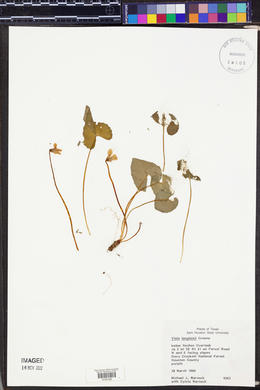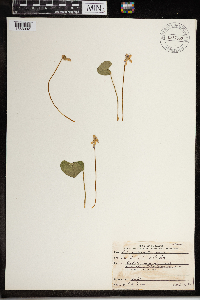Viola nephrophylla
|
|
|
|
Family: Violaceae
Northern Bog Violet, more...prairie blueviolet, wanderer violet, wild pansy, wild violet
[Viola austiniae Greene, moreViola lunellii Greene, Viola maccabeana M.S. Baker, Viola nephrophylla var. arizonica (Greene) Kearney & Peebles, Viola nephrophylla var. cognata (Greene) C.L. Hitchc., Viola nephrophylla var. nephrophylla Greene, Viola peramoena Greene, Viola pratincola Greene, Viola prionosepala Greene, Viola retusa Greene] |
Perennial herb 7 - 20 cm tall Stem: absent aboveground, leaves and flowers arising independently and directly from rootstock of thick (much greater than 3 mm diameter) rhizomes, but lacking runners (stolons). Leaves: basal, long-stalked (stalks much longer than blades), often purple-tinged or bluish below, mostly hairless, shallowly rounded-toothed, relatively small (rarely over 6 cm wide, largest up to 2 - 6 cm long), usually wider than long, somewhat kidney-shaped with blunt or rounded tip. The stipules are green, less than 1.5 cm long, and fully separate from the leaf stalk. Flowers: long-stalked (taller than leaves), dark purple throughout, about 1.5 cm long, bilaterally symmetric with two upper petals, two lateral petals, and lower petal with base modified into a rounded nectar spur. In the summer, producing ascending to arched or curving, very slender stalks terminated by very fertile flowers that do not open (cleistogamous). Sepals: five, green, oblong with blunt or rounded tips, and under 2 mm long ear-like appendages (auricles) at the base. Petals: five, separate, all differently shaped, but facing forward. The two lateral petals and lowest petal have a heavy beard of slender hairs near the base, and the slightly shorter lowest petal also is prolonged at its base into a short, rounded spur or sac. Stamens: five, separate, but very tightly arranged so anthers touch as they surround ovary. The filaments are very short (anthers not exposed), and the lower two stamens have spur-like nectaries on their backs that extend into the spur or sac of the lower petal. Pistil: with a single-chambered, superior ovary; and a single style that expands into a short, scoop-shaped stigma. Fruit: a many-seeded, green, hairless, 0.6 - 0.9 cm long, ellipsoid capsule on erect stalks. The capsule opens lengthwise from its top to disperse the olive-black seeds which have a large amount of oily endosperm, and often an appendage (aril). Similar species: Viola nephrophylla is probably most similar to V. cucullata, but that species has lighter purple flowers with an obvious darker purple throat, the spur petal is hairless and much shorter than the lateral petals, the beards at the base of the lateral petals have short club-shaped hairs, the sepals are more slender with gradually tapered long-pointed tips, and the sepal auricles are much longer (2 - 10 mm). Also quite similar is V. sororia, but that species normally has hairy leaves with sharp teeth along the edges, the flowers are over-topped by the leaves, the spur petal is mostly hairless and shorter than the lateral petals, and the capsules, which are purplish and contain light brown seeds, are on prostrate stalks. The other species in the Boreali-Americanae group with unlobed leaves that is very similar is V. affinis, but that species has longer leaves (usually longer than wide) with more sharply-toothed edges, the flowers do not extend beyond the leaves in height, the sepal tips are obviously pointed, and the capsules, which are flecked with purple and contain light brown seeds, are on prostrate or arching stalks. Flowering: May Habitat and ecology: Infrequent, occasionally found in fens, calcareous marshes, or other alkaline open wetlands. Occurence in the Chicago region: native Notes: Viola nephrophylla is one of several taxa that was known at one point under the name V. pratincola. Based on the type specimens for both names, they are clearly the same species, and since V. nephrophylla is the older name, it is the correct name (Ballard 1994). Etymology: Viola is the classical name for the genus. Nephrophylla means "kidney-shaped leaves". Author: The Field Museum Martin and Hutchins 1980, Kearney and Peebles 1969 Duration: Annual Nativity: Native Lifeform: Forb/Herb General: Acaulescent perennial, 5-25 cm tall, glabrous or nearly so. Leaves: Generally basal on petiole 2-20 cm long, broadly cordate ovate to reniform, with crenate serrate margins, apex rounded to obtuse, glabrous. Flowers: Solitary and axillary on peduncles 3-15 cm, with stipules and 5 sepals ovate to lanceolate, sepals 4-7.5 mm long, 5 petals violet, lighter and purple veined at base, 10-15 mm long, the spurred petal emarginate and bearded, spur a fourth as long as petal, spur 2-3 mm long. Fruits: Ellipsoidal loculicidal capsule, 8-10 mm long, glabrous. Ecology: Found in moist soils along streams, seeps, springs, and also in shaded sites from 4,000-9,500 ft (1219-2896 m); flowers June-August. Notes: There is some discrepancy in the nomenclature of this species, as Little 2001 (Flora of AZ Project) suggests that V. nephrophylla was misapplied and instead these species are simply a variety of V. sororia. Collection data does not support this, as SEINET and the majority of collections remain identified as V. nephrophylla. Probably worth collecting to sort out its identity. Ethnobotany: Used as a ceremonial emetic. Etymology: Viola is a classical Latin name for the genus, while nephrophylla comes from Greek nephros, kidney and phyllon, leaf, thus kidney shaped leaves. Synonyms: Viola maccabeana, V. nephrophylla var. arizonica, V. nephrophylla var. cognata, V. pratincola, V. retusa Editor: SBuckley, 2010 Lvs glabrous, relatively small, the later ones not notably larger than the earlier ones, seldom as much as 7 cm wide; fls often elevated somewhat above the lvs, narrower and more elongate than in no. 5 [Viola sororia Willd.], the relatively narrow lateral pet directed forward at an angle, tapering to an almost clawed base; spurred pet bearded or not; 2n=54; otherwise much like no. 5 [Viola sororia Willd.]. Mainly in the w. cordillera, but extending e. in cold, wet places (often with a high pH) to ne. U.S. (Mich., Wis., n. N.Y., and New Engl.) and se. Can. May-July. Gleason, Henry A. & Cronquist, Arthur J. 1991. Manual of vascular plants of northeastern United States and adjacent Canada. lxxv + 910 pp. ©The New York Botanical Garden. All rights reserved. Used by permission. From Flora of Indiana (1940) by Charles C. Deam Indiana Coefficient of Conservatism: C = 8 Wetland Indicator Status: FACW |
|
|
|




































































































